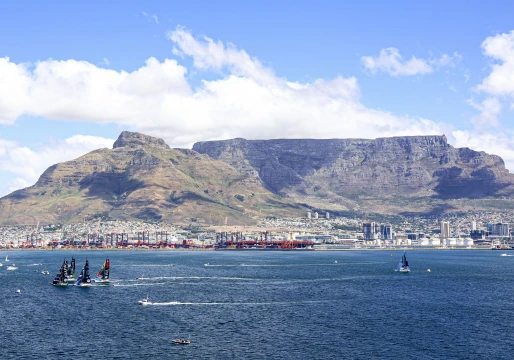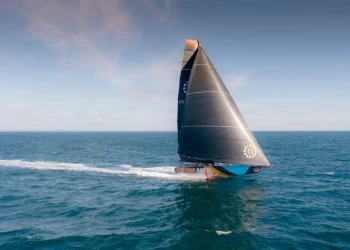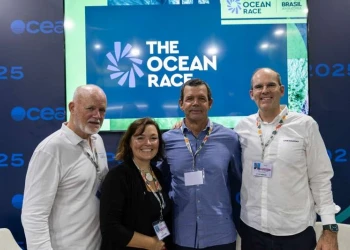
The Ocean Race, Start of the In-Port Race in Cape Town © Sailing Energy / The Ocean Race
The Ocean Race: Leg 3, an enthralling, treacherous sleigh ride
At over 12,750 nautical miles, Leg 3 of this 14th edition will be the longest ever in the 50 years since this race began. When the boats cast off from the dock at midday in Cape Town on Sunday, this will be the most emotional departure for friends and family. As the fleet heads into the most remote ocean on the planet, there is a lot at stake. There will be plenty of goodbye tears as the sailors set off on an adventure expected to last more than a month.
Two-time veteran of the race Charlie Enright, skipper of 11th Hour Racing Team, commented: “When the course for this race was announced, everybody keyed in on this leg pretty quickly as the big one. You know, it's going to be somewhere between 30 to 40 days.”
There are good reasons to love and hate the Southern Ocean. Even in a southern hemisphere spring, at such deep latitudes it can be unrelentingly cold. Cold enough for icebergs to be a threat and something to be monitored on radar. For long periods during the passage from the Cape of Good Hope to rounding Cape Horn, you’re more than a thousand miles from any other human beings. Except for when the astronauts fly overhead, about 250 miles up in space on the International Space Station.
But the Southern Ocean is also a sailor’s dream. The ultimate sleigh ride where you can have fun surfing huge waves for weeks on end. “The south can be unbelievable,” enthuses Enright. “I mean, it's big westerly winds with no leeward mark, a sailor's dream and you get to go downwind forever. But it's also a pretty treacherous part of the world. In the two previous editions of the race we’ve been either side of that. In 2014-15 we were a group of young guys and to find ourselves leading the fleet around Cape Horn was a magical moment. But in the next edition of the race we dropped a rig about 50 miles after going around Cape Horn. So the Southern Ocean can give and it can also take away.”
Paul Meilhat, skipper of Biotherm, was late signing up to The Ocean Race. The French skipper thought he didn’t have much time to round up the kind of experience he wanted on board, but Leg 3 made it an easier sell for convincing his fellow IMOCA sailors to join the crew. “When I announced the project and said I was looking for crew, they all asked to do this leg. This is the leg that everybody - the public, the journalists - all speak about because it's almost half of the race in terms of miles, it’s the longest in the history of this race. So, yes, it's a big one.

"But we mustn’t forget that we are going to have 10 [scoring] coefficients. This is a big part of the race, but we must focus not just on this leg but about The Ocean Race as a whole. Which is why the most important objective is to be in Itajaí to be able to finish the race.”
Two other French skippers are also very aware of the importance of this leg in determining the outcome of The Ocean Race four months from now. Neither Kevin Escoffier nor Benjamin Dutreux want to take the results of the first two legs for granted. Escoffier and Team Holcim - PRB have a perfect score with two leg victories down the Atlantic but are taking none of their early success for granted, while Dutreux and GUYOT environnement - Team Europe have finished last in both opening legs.
Dutreux is adamant that the scoreboard doesn’t tell the story of a much closer level of performance throughout the fleet. After all, the GUYOT team did hold the lead for large chunks of Leg 2. “I am very happy with the the beginning of the race, even if the leaderboard doesn’t show that,” said Dutreux who sat out the second leg from Cabo Verde. “The scoreboard, it’s only numbers, and what I feel is that the level is very high and very close in the fleet. We have a fight with the other boats, and our points are not good, but I’m very happy with the fight and effort we put into sailing the boat, and that is the most important factor. I feel we are making good progress, and I’m looking forward to getting back on board and fighting for 20 per cent of the race on this crazy leg.”
Team Holcim - PRB skipper Kevin Escoffier is looking his usual energetic self, even if he’s not quite feeling it. “We had some rest, but not enough, in Cape Town. I would have liked to spend more time here, and for the shore crew it has been difficult getting the boat ready in time for the next leg. There is still plenty of race to come. Like Paul [Meilhat] said, the most important thing is to finish in Itajaí.
"When we started in Alicante in January, we were already pushing the boat to 100 per cent of what we thought we could do, maybe more. I don’t know if we are pushing too hard on the boat. I think it was pretty easy in the Atlantic, because we have references from other experiences in the Atlantic. For the next leg going into the Southern Ocean it will be completely different. We have to find a new of setting up the boat, to find a good average speed without pushing the boat too much. With Team Holcim - PRB we have never done 30 days in a row at sea. It’s the unknown, but we’re looking forward to it.”

So is Team Malizia’s Boris Herrmann, who makes no secret that his boat has been built with the Southern Ocean in mind. “You can’t build a boat that’s good for all kinds of wind and wave conditions,” said the Team Malizia skipper. “But downwind in strong conditions is what we and (our designers) VPLP designed this boat for. I hope we can take advantage of this on Leg 3 and prove that the boat is good for such conditions in the Southern Ocean.”
Herrmann also notes that there needs to be change of mindset when heading out of the Atlantic and into the south. “What we are about to do, I think it is really the pinnacle of The Ocean Race this time and very different from the other legs. It’s almost a different type of yachting or racing. In the Atlantic we can be used to do really very close racing, to be very focused on performance all the time. But going into the Southern Ocean is also a big adventure.
“If we need rescuing, it can take 10 days for a warship to get to these regions to be able to help you. We are thousands of kilometres away from the nearest land. We're really on our own.”
Leg 3 is scheduled to start at 1415 local time in Cape Town, 1215 UTC.
The forecast for Sunday's race start is 15-20 knot southerlies, with the wind in the start area quite shifty due to the local geography and the wind coming from the shore.





